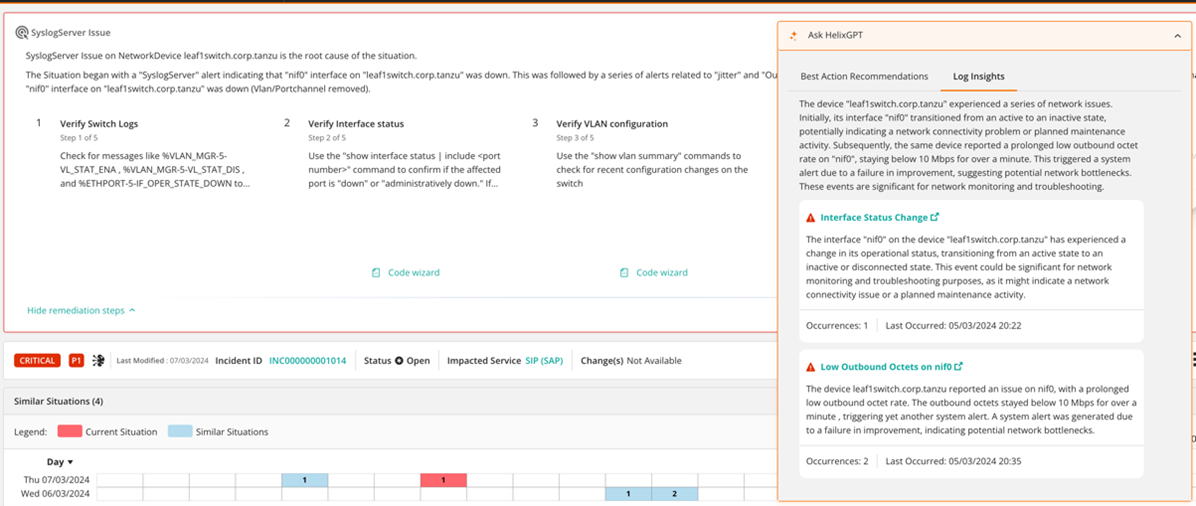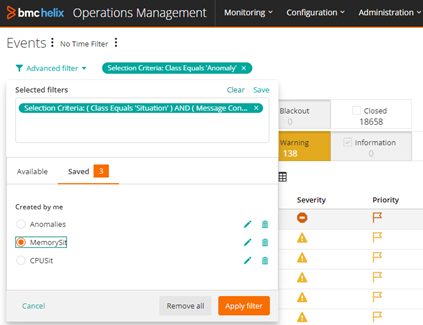Today’s complex and dynamic architecture makes it increasingly difficult to trace an error back to the root cause of the problem. This results in slow incident response time, which can lead to service degradation and expensive downtime. We’re excited to announce new capabilities in the BMC Helix observability and AIOps solution portfolio that help teams improve service reliability and mean time to repair (MTTR) while streamlining incident management.
The BMC Helix ITOM 24.2 release introduces OpenTelemetry support for distributed tracing, BMC HelixGPT-powered log insights in the context of a situation, new service blueprints, and enhanced integration for correlation of incidents to situations. Other enhancements include expanded BMC Helix Discovery Technology Knowledge Updates (TKUs) and improved usability through advanced event filtering.
These key enhancements make cloud-native application data collection easier for IT operations and site reliability engineering (SRE) teams and reduce the time teams must spend manually troubleshooting problems or poring over complicated information.
Troubleshoot more efficiently with OpenTelemetry tracing
OpenTelemetry (OTel) is the open-source standard for instrumenting, generating, collecting, and exporting telemetry data to gain observability over microservices. Through the OTel collector, IT teams that include DevOps, IT operations (ITOps), SRE, and platform engineering, can get traces into BMC Helix ITOM, our observability and AIOps solution, without needing to use a third-party monitoring tool.
Our solution derives the rate, errors, and duration (RED) metrics from all the spans ingested to provide a highly accurate picture of an application’s behavior and give users a standardized starting point for troubleshooting microservices or any request-driven applications. By viewing a trace, you can track the complete flow of a request from one service to another and identify which part of the application is causing issues such as errors or latency concerns.

Figure 1. Visualizing a trace.
BMC Helix ITOM enriches OpenTelemetry trace data with a powerful topology mapping and visualization that gives IT teams a better understanding of the overall service and its dependencies and isolates root causes by correlating traces with topology, metrics, and events in the context of the problem. If an application issue occurs, you can identify the impacted application quickly. From that impacted node, you can launch the dashboard that shows the problem’s contextual RED metrics. Clicking on any error status will direct you to the relevant traces to pinpoint the issue.
In addition, the topology derived from those traces get reconciled and added to the solution’s network infrastructure topology mapping and visualization, giving IT teams end-to-end service visibility. This helps identify issues that stem from errors within the microservices or changes to the infrastructure or network.
Resolve incidents faster with AI-powered log insights
BMC Helix ITOM continues to invest in artificial intelligence and machine learning (AI/ML) capabilities to improve MTTR and team productivity. In January, we introduced the Best Action Recommendation (BAR) feature to help IT practitioners resolve issues and eliminate days of troubleshooting. Trained on past incidents, situations, and remediation actions, BAR uses generative AI to recommend potential solutions to resolve problems. IT administrators, network operations center (NOC) operators and SREs can use the “Ask BMC HelixGPT” tool to ask questions and get more details to questions such as, “What’s the impact of the issue?” and “Has this situation happened in the past?”

Figure 2. Log insights leveraging BMC HelixGPT.
Now, with log insights for situations, teams gain additional insights with important trends and patterns found in the context of the problem. Using generative AI for log data further enhances the functionality of BAR by reducing the noise and the time it takes to identify unusual behaviors in log data. Log insights provides a summary of the issue and a breakdown of the different occurrences so teams can make informed decisions with a clear explanation of the problem.
Automate incident management through a single interface
When you’re under pressure to respond to production incidents, nothing kills productivity more than context switching. The BMC Helix observability and AIOps solution portfolio eliminates context switching by enabling cross-launching between the situation view (where a generative AI-based summary and the root cause of the issue is shown) to your IT service management (ITSM) tool. By creating a single incident for many correlated events along with the impacted service and configuration item (CI) details, the solution significantly reduces the number of tickets created, as well as their corresponding costs and incident noise. ITSM and ITOps teams can now focus and collaborate more efficiently on solving critical issues.
Get better control of events
The new advanced event filter capability helps users view only the events they want to focus on to prioritize critical issues and diagnose them early by:
- Creating new filters and viewing events that match the specified priorities.
- Saving hundreds of filters and switching between them within the intuitive user interface (UI).
- Grouping devices and services based on technology, role, and geography.

Figure 3. Advanced event filter in BMC Helix Operations Management.
Other enhancements
New service blueprints for service modeling
Speed the time to value (TTV) for customers creating service models with new out-of-the-box service blueprints for application performance monitoring, networks, cloud infrastructure, and mainframe that reduce contextual noise and enable root cause analysis.
New BMC Helix Discovery TKUs
Get expanded BMC Helix Discovery TKU content with new cloud, Kubernetes, storage, and network coverage that improves visibility into your IT environment. For the full list, see our documentation.
Want to see it working together? We’ll be happy to show you the latest features; request a demo today.
These postings are my own and do not necessarily represent BMC's position, strategies, or opinion.
See an error or have a suggestion? Please let us know by emailing blogs@bmc.com.






